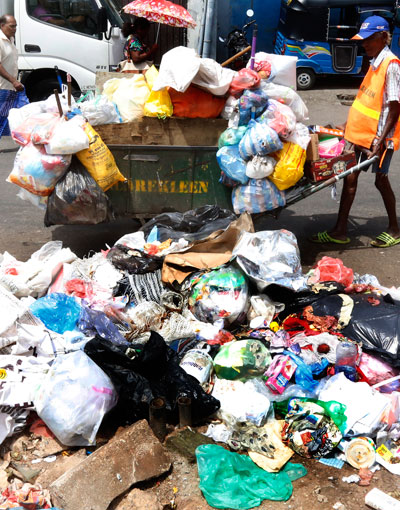News
Garbage projects coming on stream to help ease disposal issues
View(s):Amid piles of garbage on the streets with no proper disposal sites, a few solid waste management projects are expected to start operations by the end of next year.

An eyesore: Garbage piling up in Colombo city
The most talked about solid waste management project, the sanitary landfill in Arawakkalu, Puttalam, will commence construction this month and the Megapolis and Western Development Ministry anticipates that operations will begin by November next year.
The scope of the landfill is said to cover garbage collected by the Colombo Municipal Council, and some local councils in Colombo suburbs, Wanathamulla and Puttalam.
“Plans for transporting garbage by train have been proposed and now it’s in the stage of implementation,’’ Jayavilal Fernando, project director of solid waste management project of the Megapolis and Western Development Ministry said.
He added, that two trains will function every day and each will carry 600 tonnes of garbage.
“People have a common misconception that sanitary landfills are likely to turn out to be dumping sites and fear the birth of another Meethotamulla. We don’t want another Meethotamulla either,’’ he emphasised.
According to Mr Fernando, the technology used in sanitary landfills are safe as the cells will have protective liners and garbage will be deposited in them, instead of creating piles of garbage.
Meanwhile, the waste-to-energy project which is a private public partnership project, will be set up in Karadiyana and Kerawalapitiya. The project is a joint-venture between a private company and the waste management authority.
The Central Environmental Authority has initiated a project to construct sanitary landfills in four districts — Jaffna, Polonnaruwa, Anuradhapura and Galle on land of 20 to 25 acres.
“Tenders will be called by the end of this year following which construction will commence and the landfills will start operations by 2020. This is a Korean- funded project,’’ CEA’s director solid waste management Sarojini Jayasekara said.
According to Ms Jayasekara, the landfills were initially to come up in Kalutara, Kandy, Anuradhapura and Galle. However, due to public protests and regional political interference in Kalutara the project had to be shifted to Polonnaruwa and the land selected in Kandy was declared as a high-risk landslide area after feasibility studies. Hence Polonnaruwa district was chosen for the project.
The first long-term project by the CEA was initiated by constructing a sanitary landfill in Dompe. This pilot project began due to emergency needs to dispose garbage using a land of one hectare. Although the project was ready for operation in 2009, the landfill started functioning officially only in 2015 due to public protests in the area.
“We were able to convince the people in Dompe that the new technology used for garbage disposal is not going to be the conventional garbage dumping where mountains of garbage pile up and encouraged a large number of public participation for the project,’’ she said.
She suggested that each district must have at least one sanitary landfill.
“The biggest challenge we are faced with is trying to find proper land that would ideally suit a sanitary landfill,’’ she said.
According to Ms Jayasekara, the land must be a high land and not a low land, marshy lands are not recommended, the area should not be a residential area, and the access roads leading to the land should be accessible.
Meanwhile, small-scale sanitary landfills will be initiated in Kataragama, Ratnapura and Ampara.
A senior official of the Colombo Municipal Council said that it is important to change the attitude of the people as there is a lack of community participation and public support.
“Some people have still not got used to segregating garbage, especially those living in underserved settlements in Colombo north and Colombo central,’’ she said.
Meanwhile, the CMC is faced with illegal garbage dumping in Maligawatte, Maligakanda, Kotahena, Dematagoda and Wanathamulla.
“We have informed the Environment Police as people throw garbage at night. The CMC is hoping to fix CCTV cameras in these areas,’’ he said.
About 375 metric tonnes of bio-degradable waste and 175 metric tonnes of non-degradable waste is transported by CMC vehicles every day.
“CMC vehicles are used and the CMC is also hiring vehicles. This time we have allocated a considerable amount from the budget to purchase vehicles,’’ she said.

